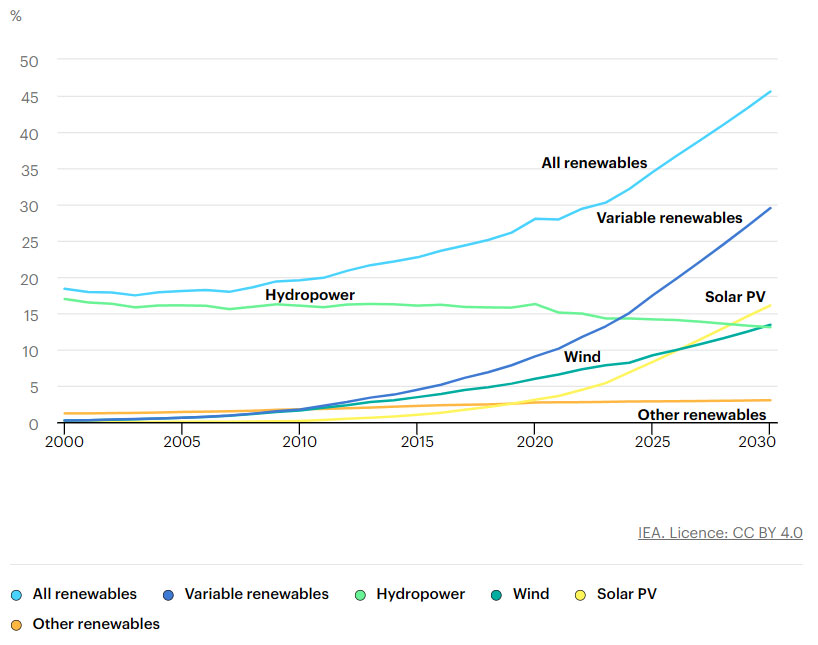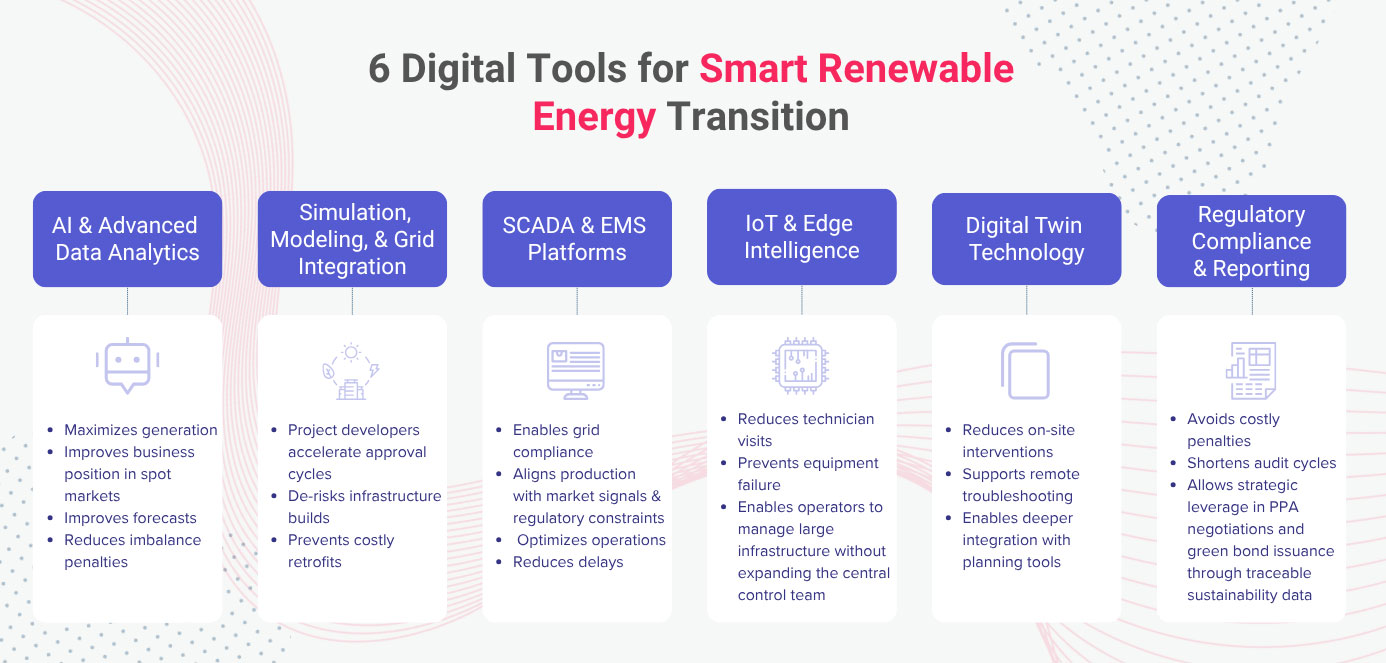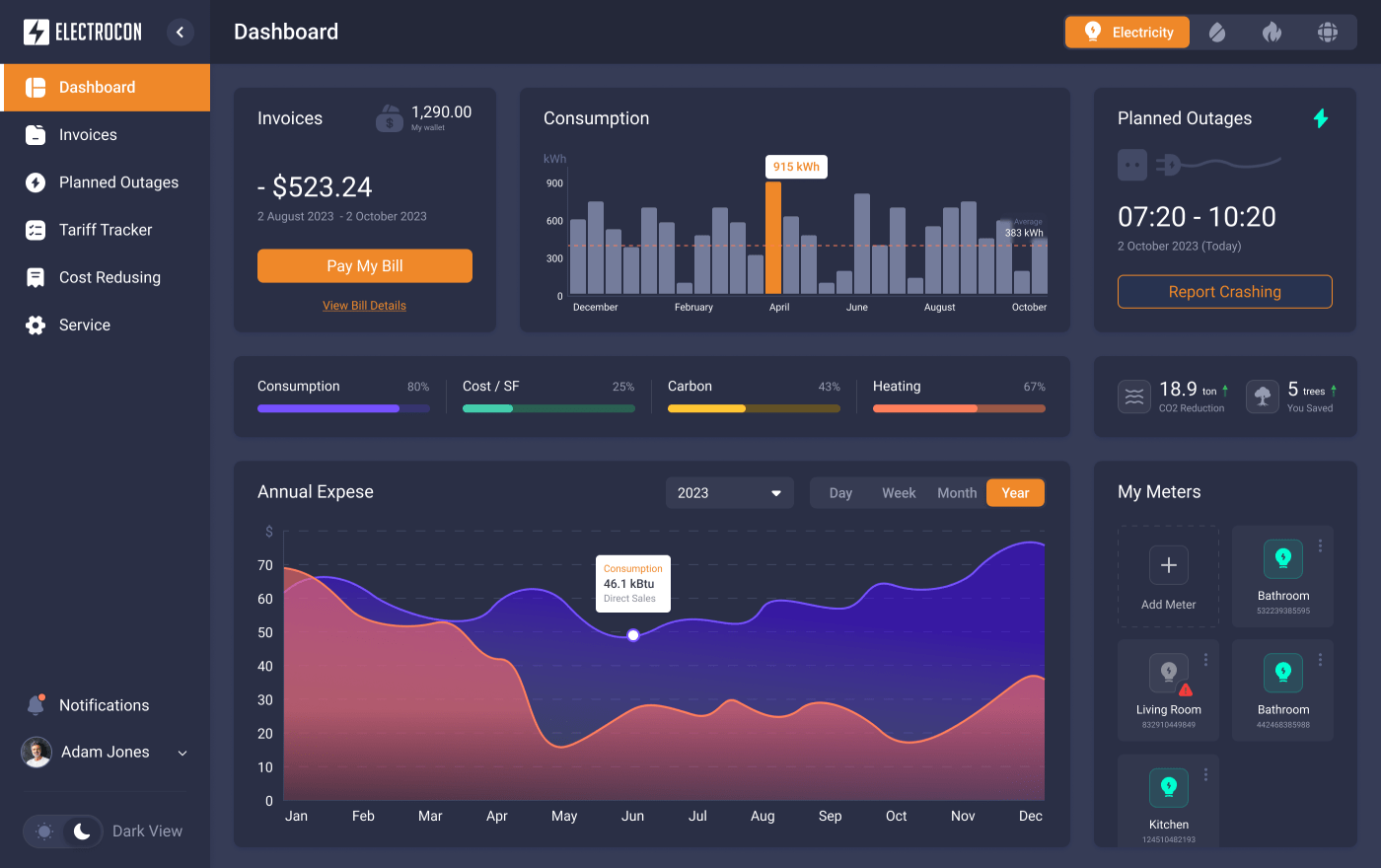Summary
Digital tools like AI, EMS, IoT, and digital twins are transforming renewable energy operations. They boost efficiency, reduce costs, automate compliance, and improve asset longevity. Smart software = smarter renewables.
As renewable energy scales up, the old way of running assets just doesn’t cut it anymore. Scaling renewables doesn’t just require more turbines or solar panels — it demands smarter tools. And without them, even the greenest projects leak time, money, and megawatts.
This article explores how digital tools — like AI, EMS, digital twins, and IoT — can streamline operations, boost efficiency, and make renewable energy smarter, more reliable, and cost-effective. From real-time monitoring to predictive maintenance and regulatory compliance, discover which technologies can transform your renewable energy operations — and how custom software solutions can help you stay ahead.
The Evolving Landscape of Renewable Energy
As wind, solar, hydro, geothermal, biomass, and other energy assets become key components of the global energy mix, the shift toward renewable energy is exposing deep structural and operational limitations that traditional fossil-fuel-based systems were never designed to handle.
According to the IEA.org research, in the coming five years, renewable energy is on track to hit several major milestones. In 2025, electricity generated from renewable sources is projected to outpace coal-powered generation. In 2026, both wind and solar are expected to individually exceed nuclear power in terms of electricity output. Looking further ahead, solar PV is set to become the world’s top renewable energy source by 2029, overtaking hydropower — with wind energy expected to follow suit by 2030.

Today, utility providers, renewable asset operators, EPC (Engineering, Procurement, and Construction) firms, and independent power producers (IPPs) are dealing with a new class of challenges:
- Intermittent & Variable Generation: Weather-driven output makes it difficult to balance supply and demand, leading to curtailment or grid instability without real-time adjustments or predictive control systems.
- Decentralized Infrastructure: Unlike centralized thermal plants, renewables are dispersed across geographies — rooftop solar, offshore wind, run-of-river hydro — introducing significant complexity in grid coordination and SCADA (Supervisory Control and Data Acquisition) integration.
- Limited Asset Visibility: Legacy monitoring tools and fragmented data sources make it hard to track turbine performance, panel degradation, or hydro discharge efficiency in real time, leading to reactive instead of proactive decision-making.
- Inefficient Forecasting & Dispatch Planning: Without advanced analytics and machine learning, many providers still rely on historical trends or weather station estimates, which limits the accuracy of day-ahead and intra-day market participation.
- Regulatory Burdens: Increased scrutiny around emissions reporting, ESG (Environmental, Social, and Governance) metrics, and grid code compliance demands standardized, auditable data — often across multiple jurisdictions.
- High Operational & Maintenance Costs: Preventable downtimes, inefficient work orders, and lack of predictive diagnostics keep Operations and Maintenance (O&M) costs elevated, especially for remote or offshore assets.
These challenges are compounded by the presence of aging infrastructure, underfunded digital systems, and siloed operational data that can’t support high-resolution forecasting, asset health modeling, or dynamic grid participation.
The pressure is on to not just adapt — but to digitally transform.
6 Digital Tools for Smart Renewable Energy Transition and How They Help Businesses
As the renewable energy sector matures, operational excellence and profitability depend increasingly on digital intelligence. From real-time monitoring to predictive automation, cutting-edge software platforms are reshaping how wind, solar, hydro, and other assets are designed, operated, and maintained.
Let’s examine the key digital tools for renewable energy that can power up this transformation.

1. AI in Renewable Energy and Advanced Data Analytics for Renewable Assets
Artificial Intelligence (AI) and machine learning (ML) have become foundational to renewable energy optimization software. By ingesting multi-source data — weather forecasts, asset telemetry, grid demand — AI-powered platforms deliver:
- Real-time performance diagnostics for early fault detection and production optimization;
- Generation forecasting using advanced weather modeling and irradiance/wind-speed data fusion;
- Anomaly detection and predictive maintenance based on sensor trends and failure probabilities (auto-flagging of irregular patterns using unsupervised learning);
- Automated energy dispatch to maximize participation in spot markets and minimize curtailment.
Business Impact: Wind farms, for example, can leverage renewable energy optimization software powered by AI to fine-tune yaw alignment and blade pitch in real time, improving capacity factors and reducing energy loss from poor aerodynamics — ultimately raising revenue per megawatt (MW). For hydroelectric stations, smart energy forecasting tools and machine learning in energy help integrate weather data, historical performance, and real-time water flow rates to deliver enhanced dispatch optimization.
By combining renewable energy analytics, real-time energy monitoring, and automated grid balancing, operators can not only maximize generation but also improve their position in spot markets. Better forecasts mean better bidding strategies, reduced imbalance penalties, and smarter reservoir control.
Read Also How Adaptive AI Takes the Interaction Between Business and Customers to a New Level
2. Digital Twin Technology for Solar, Wind, and Hydro Energy Optimization
Digital twin energy systems simulate the full behavior of a physical asset under varying operational and environmental conditions, unlocking new opportunities in renewable energy management software and intelligent asset optimization. This cutting-edge approach to software for renewable energy enables:
- Scenario modeling to test grid events, extreme weather, or control strategy changes;
- Predictive performance simulations to assess long-term asset degradation and output;
- Condition-based monitoring for prioritizing maintenance schedules based on actual wear and risk.
Business Impact: Digital twins reduce on-site interventions, support remote troubleshooting, and enable deeper integration with planning tools. And by combining digital twin energy systems with IoT in renewable energy and machine learning in energy, companies can implement smarter, scalable predictive maintenance strategies that directly lower O&M costs. These tools are particularly impactful in offshore wind and run-of-river hydro installations, where physical inspections are costly and time-consuming.
As a core part of modern renewable energy software development, digital twins also allow utilities and energy producers to simulate load responses before actual implementation, plan system upgrades with minimal risk, and reduce reliance on costly on-site inspections.
3. SCADA for Renewables and EMS Platforms for Distributed Energy Resources
Modern Supervisory Control and Data Acquisition systems, when integrated with enterprise-grade EMS platforms, act as the digital backbone of multi-source renewable portfolios. They deliver:
- Real-time asset control and fault localization across distributed energy resources (DERs);
- Automated load balancing in hybrid systems combining solar, wind, storage, and grid-tied assets;
- Intelligent alarm management to prevent cascading failures and prioritize response;
- Historical data warehousing for trend analysis, benchmarking, and performance optimization.
Business Impact: EMS and grid management platforms help renewable asset owners get the most out of their infrastructure. Smart EMS software empowers energy producers to participate in day-ahead and intraday markets, match load patterns, and avoid grid imbalance penalties — all while meeting ISO and regional compliance benchmarks.
EMS solutions also enable grid compliance by aligning production with market signals and regulatory constraints. Whether running a wind farm or a regional hybrid cluster, optimized operations drive bottom-line results. If additionally integrating project management software, it’s also possible to reduce delays by unifying engineering, procurement, and construction (EPC) teams.
For example, in one of our projects, we developed a custom energy management platform (EMS) for a utility company operating a solar-powered infrastructure. After implementing the system, the company is able to aggregate real-time data from solar panels, inverters, and storage units and to have remote control, instant alarm notifications, and energy usage visualization. As a result, the client reduced energy loss by 30%, improved grid responsiveness, and gained full control over distributed assets through a single, intuitive dashboard, and reduced the need for on-site technicians by half.

Check clickable prototype: Custom Energy Management Software
4. IoT and Edge Intelligence in Renewable Energy
IoT sensors embedded in turbines, PV modules, inverters, substations, and hydro gates offer high-frequency, high-resolution asset data. When paired with edge computing, they provide:
- On-site analytics for fast decision-making without waiting for cloud processing;
- Equipment-level diagnostics that capture micro-failures often missed by centralized monitoring;
- Secure, low-latency data transmission even in remote, bandwidth-constrained regions.
Business Impact: Edge + IoT reduces technician visits, prevents equipment failure, and enables operators to manage large infrastructure without expanding the central control team. Micro-failures are caught early, reducing cascading equipment damage and downtime. Hydro plants benefit especially — remote stations often lack connectivity, and local analytics provide critical insights in real time.
5. Simulation, Modeling, and Grid Integration Software
The integration of renewable energy into existing power grids is no longer just a physical or engineering challenge — it’s a strategic digital transformation powered by renewable energy software solutions. Today’s smart grid technology relies heavily on advanced renewable energy development software and simulation tools to ensure seamless integration of diverse energy sources, including solar, wind, and hydro.
Modern renewable energy software enables:
- Load-flow and transient stability simulations to model how new assets impact system dynamics;
- Dynamic grid-code compliance modeling for onboarding distributed generation (DG);
- Contingency analysis to preemptively assess the impact of outages, voltage dips, or black start events.
Business Impact: With modeling software, project developers accelerate approval cycles, de-risk infrastructure builds, and prevent costly retrofits by modeling future scenarios before physical deployment. Digital control systems transform passive renewable assets into active, grid-supportive players. These tools are critical for independent power producers working with solar + storage, wind clusters, or hydro stations feeding into vulnerable grid zones.
Read Also Top 7 Life-Changing Trends in Energy & Utilities Industry
6. Regulatory Compliance and Reporting Automation in Energy
Regulatory compliance is no longer just about ticking boxes — it’s a competitive differentiator. As ESG mandates tighten and global standards like ISO 50001, CDP, and GRESB gain traction, the need for robust, auditable, and automated systems becomes mission-critical. This is where renewable energy software solutions shine.
With the right renewable energy management software, companies can:
- Automated generation of compliance reports for carbon intensity, efficiency ratios, and curtailment;
- Standardized documentation workflows for ISO 50001, GRESB, CDP, and regional grid codes;
- Centralized audit trails for providing transparency to regulators and investors.
Business Impact: When integrated into broader renewable energy software development strategies, compliance tools help renewable providers not only avoid costly penalties but unlock growth opportunities. Business avoids costly penalties, shortens audit cycles, and gains strategic leverage in power purchase agreement (PPA) negotiations and green bond issuance through traceable sustainability data. The right reporting tools are a strategic asset in PPA negotiations, green bond issuance, and market expansion.
Read Also Optimizing Field Operations: The Role of Workforce Management Systems in Energy and Utilities
What Renewable Energy Leaders Want to Know (And What We Tell Them)
Whether you’re running a utility-scale solar operation, deploying wind turbines across borders, or managing hybrid assets with storage, you’re under pressure to adapt fast. Rising grid complexity, tightening ESG regulations, global supply chain risks, and evolving AI standards are rewriting the rules.
We always pay close attention to what our clients want — and while the tech is advancing fast, the questions remain deeply strategic. Here’s top 8 questions of what forward-thinking energy executives are asking due to the latest world changes, and how we respond.
Q1: What’s the ROI of implementing a custom EMS or SCADA platform?
Most clients see ROI within 12-18 months. Benefits include lower energy losses, fewer technician dispatches, and optimized dispatching — often resulting in 20-30% O&M savings.
Q2: Can these systems integrate with the existing hardware?
Yes. Custom software can be designed to interface with existing SCADA protocols (e.g., Modbus, OPC Unified Architecture), inverters, battery controllers, and even Excel-based legacy systems.
Q3: We operate in multiple regions — is it possible to ensure compliance with local regulations?
Absolutely. Each implementation is localized to the client’s regulatory environment.
Q4: How long does system implementation usually take?
A typical EMS or digital twin deployment can take from 6 months, but it all depends on project scope and integration needs. We offer phased rollouts for high-priority assets.
Q5: Do I need AI from day one?
Not necessarily. Many clients start with rule-based systems and evolve into AI-driven insights as data volumes grow. For example, the software we develop is modular — you can scale as needed.
Q6: How secure are these systems for the energy sector? We’re seeing more cyberattacks targeting energy infrastructure.
Security is built in from day one. Multi-layer access control, real-time intrusion detection, and secure APIs come standard.
Q7: How can digital tools help with workforce shortages and knowledge gaps?
Smart dashboards, automated reporting, and remote monitoring reduce the need for specialized on-site staff. Plus, custom renewable energy management software can embed SOPs, alert logic, and guided diagnostics for new hires or rotating teams.
Q8: What if we’re not ready for a full transformation? Is it even possible nowadays to start small?
You can absolutely start small, there is no need in becoming a copycat. Many clients begin with a single module — like predictive maintenance or reporting automation — and expand as results and confidence grow. Agile development allows fast wins without big upfront risk.
Conclusion: Smarter Energy Needs Smarter Tools
The energy transition isn’t just about going green — it’s about going smart. As wind, solar, hydro, and hybrid assets become more complex and distributed, digital tools are no longer optional. From AI-driven performance optimization and predictive maintenance to automated reporting and grid simulation, custom software is the multiplier that helps renewable energy businesses stay competitive, compliant, and profitable.
The key? Start with your unique operational challenges and build digital solutions that grow with your assets, not against them. Whether you’re optimizing a single site or scaling globally, a strategic approach to energy software development can unlock massive value — fast. So, contact us if you want fast development and a successful result.